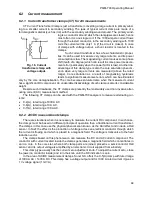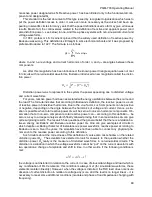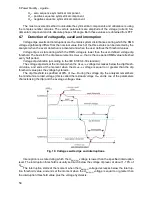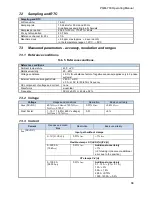
PQM-700 Operating Manual
54
where
U
1
and
I
1
are effective values of fundamental components of phase-to-neutral voltage and
current.
6.4.7 Power factor
True Power Factor or Power Factor (TPF or PF) is the value which takes into account also the
presence of higher harmonics. For sinusoidal systems, it is equal to Displacement Power Factor
(DPF), popular cos
.
Hence, DPF is a measure of phase shift between the fundamental voltage and current compo-
nents:
𝐷𝑃𝐹 =
𝑃
1
𝑆
1
=
𝑈
1
𝐼
1
𝑐𝑜𝑠𝜑
𝑈1𝐼1
𝑈
1
𝐼
1
= 𝑐𝑜𝑠𝜑
𝑈1𝐼1
The general formula for True Power Factor is:
𝑃𝐹 =
𝑃
𝑆
In case of a purely resistive load (in a one-phase system), the apparent power is equal to active
power (in terms of value), and reactive power equals zero, so such load fully uses the energy po-
tential of the source and the power factor is 1. Appearance of reactive component inevitably leads
to reduction of energy transmission effectiveness
– the active power is then less than apparent
power, and the reactive power is increasing.
In three-phase systems, the power factor reduction is also influenced by receiver unbalance
(see discussion on reactive power). In such systems, correct power factor value is obtained using
the effective apparent power
S
e
that is the value defined, among others, in the IEEE 1459-2000
standard.
6.5
Harmonics
Decomposition of periodic signal into harmonic components is a very popular mathematical
operation based on Fourier’s theorem which says that any periodic signal can be represented as a
sum of sinusoidal components with frequencies equal to multiples of basic frequency of such signal.
Time-domain signal can be subjected to Fast Fourier Transform (FFT) to receive amplitudes and
phases of harmonic components in the frequency domain.
In a perfect situation, voltage is generated in a generator which at output gives a pure sinusoidal
50/60 Hz waveform (absence of any higher harmonics). If the receiver is a linear system, then also
current in such situation is a pure sinusoidal waveform. In real systems, voltage and current wave-
forms can be distorted, hence in addition to the fundamental component there must be harmonics
of higher orders.
Why is the presence of higher harmonics in the system not desirable?
One of the reasons is the skin effect which involves pushing out the electrons from the center of
conductor towards the surface as the current frequency is increasing. As a result, the higher the
frequency, the smaller the effective conductor cross section which is available for the electrons,
which means that the conductor resistance is increasing. Consequently, the higher the current har-
monics, the higher effective cabling resistance for this harmonics, and this inevitably leads to more
power losses and heating.
A classic example connected with this effect is related to neutral conductor in three-phase sys-
tems. In a system with little distortion, little unbalance and a balanced (or slightly unbalanced) re-
ceiver, the current in neutral conductor has the tendency of zeroing (it is much smaller that RMS
phase currents). Such observation has tempted many designers to obtains savings by installing the
cabling in such systems with neutral conductor of a smaller cross section than in phase conductors.
And everything went well until the appearance of odd harmonic orders which are multiples of 3
(third, ninth, etc.). Suddenly, the neutral conductor began overheating and the measurement
Summary of Contents for PQM-700
Page 85: ...85 Notes...
















































